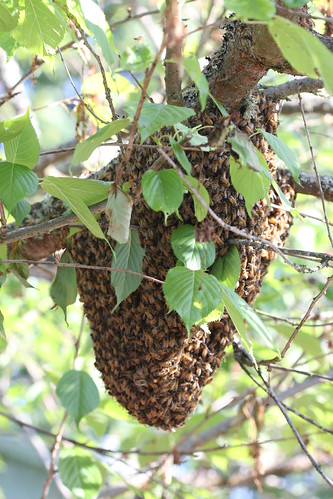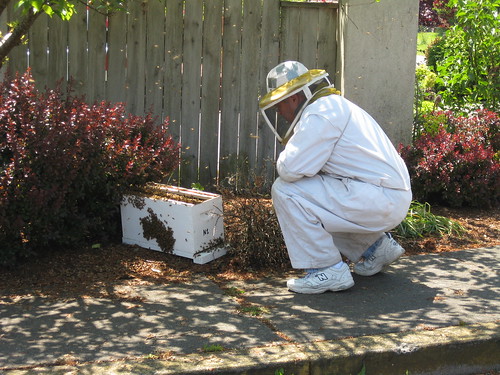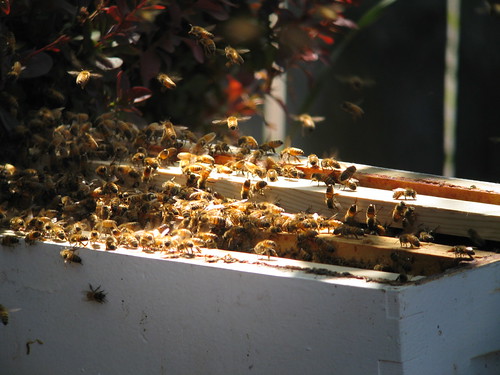In their recent book A World Without Bees, Alison Benjamin and Brian McCallum paint a grim picture of what life would be like for humans if it weren’t for bees. Most of what we eat grows as either a result of direct pollination by bees or, in the case of livestock such as cattle, pigs, and poultry, as a primary consumer itself of crops pollinated by bees. In the U.S. alone, the human labor force required to replace the the European Honey Bee, Apis mellifera, in their natural pollination activities and manually pollinate the various crops currently grown each year would cost approximately $90 billion dollars annually. The problem is that the bees are disappearing. Whether the cause is Colony Collapse Disorder, the Varroa mite, an array of diseases, plant hybridization, or industrial-scale agriculture, the fact remains that without bees, we are all in serious trouble. Albert Einstein himself is reported to have said many years ago that “if the bee disappeared off the surface of the globe then man would only have four years of life left.”
Thus when, on a recent late May day my wife returned home from her walk with the family dog and told me that a large swarm of bees was gathering just up the street, I was both gladdened and concerned. I was gladdened to see that even with the ever-worsening news of the state of bees that swarms still occurred. In fact, I felt actually a little unjustifiably honored that one was occurring in our very neighborhood; it was as if Mother Nature herself was rewarding me with the sight for being a devoted naturalist. However I was also worried as I knew all too well that many people still have not yet come to understand the plight of bees, of our absolute dependence upon them for our own survival, and react to them out of fear and ignorance by trying to kill them. As ours is an area frequented by fitness walkers and in which many small children live, it was only a matter of time before someone started dialing their telephone trying ot contact an exterminator.
Thus I grabbed my camera and mobile telephone, and headed to the location of the colony. It was indeed a colony of European Honey Bees, Apis mellifera, numbering in the thousands of bees. Previous reading about bees led me to suspect it was the result of a new queen leaving an established colony and setting out with a portion of that colonies bees in search of a site for a new hive. While some of the bees were busily flying all around the area, the vast majority were clustering on one branch of a tree just off the street. They were completely peaceable, sated with feeding, not worried about defending a hive (which they had not yet established) and a threat to no one who didn’t directly threaten them.
Knowing that while they were likely only passing through and could be expected to move on in a day or so, the chance of someone panicking and calling an exterminator was high, thus the movement of the colony to a safe location was absolutely necessary. Ours being a small town in a rural county, and it being Memorial Day weekend, there were not many people who could be called in to help. Fortunately, Herb from the Oregon State Beekeepers Association was at home and within a few hours at the site. Herb suited up and in a matter of minutes was ready to transfer the colony from the branch to a temporary hive for transportation.
The movement of the colony was flawless. Herb placed a temporary hive with some old bits of honeycomb in it for “motivation” under the colony and with one stout shake of the branch most all the bees, including the queen, dropped directly and safely into the awaiting hive.
Herb made certain that all was well after “the shake.” Seeing that it was, he strapped a lid on the top of the hive, leaving an entry / exit port open for the scouting bees to finish their daily rounds and return to the hive by evening. He explained to all the assembled onlookers that the entire colony would now return to the new hive by evening, when he would return and retrieve the hive in order to move it to a new location where the colony could live safely and continue their normal activities.
Late that evening, I received a call from Herb to let me know that he had indeed picked-up the hive and all was well.
Thanks to Herb and his dedicated professionalism, the ongoing work of the Oregon State Beekeepers Association, and a small group of interested and well-meaning neighbors, thousands of bees are still alive, active, and pollinating the surrounding plants to their hearts content rather than lying dead on the ground as the result of an exterminators poisons.
Even though I have previously worked with various conservation groups for the preservation of species and habitat for a variety of creatures, I cannot think of another time when I felt so good about having done something. Perhaps it was because I knew that thousands of bees would remain in the fields continuing their inestimably valuable work. Perhaps it was because it was done so close to our home. However most likely it was because that the entire time the activities that led to the successful movement of the colony were taking place our nine year old daughter was right by my side seeing that, regardless of the scale of the activity, you can indeed make a difference in the conservation of nature. The famous words of Dr. Seuss’ Lorax continue to ring in my head “Unless someone like you cares a whole awful lot, nothing is going to get better; it’s not.” On a sunny day in May, my family and I, as well as our neighbors Sherri and Ron, Mike and Patty, Mike and Chris, Marty and Nancy, and of course Herb of the Oregon State Beekeepers Association who along with his wife made two sixty plus mile round trips to make it all possible, took the time to care, and we sincerely hope as a result that, even if only a tiny bit in the grand scheme of things, it “got better.”
—
For bee colony collection in Oregon, a list of beekeepers can be found here. Outside Oregon in the U.S., visiting the American Beekeeping Federation website can help discover the organization in your own state.
For more information about bees specifically and the importance of pollinators in general to the ecosystem, please visit the website of the Xerces Society.
—
All images were recorded using a Canon PowerShot SD1100 IS digital camera. The video and the close-up of the bees in the hive were digiscoped using the Canon PowerShot SD1100 IS, a Swarovski ATS 80mm HD spotting scope, a Swarovski 30x W eyepeice, and a Swarovski DCB digital camera adapter.





May 25, 2009 @ 14:59
What a wonderful tale. You should be so proud of what you’ve done!
May 26, 2009 @ 09:03
Isn’t it amazing that something as tiny as a bee could determine mankind’s ability to grow food to sustain life? I think you have paid it forward very well. Thank you for being such a good steward!
May 26, 2009 @ 09:28
Great story, John. And thanks for the links. I did experience a swarm at a cousin’s house in upstate NY. The bees left after awhile but in another case where they might cause people to call the exterminator, this info is very handy. We can’t lose any more bees!
May 26, 2009 @ 15:41
I read your post this morning and just now got off the phone with a local landowner who has found a swarm on his property. Thanks to you I remembered that we also have a local beekeeping group who I put him in touch with. I guess you could say you have now saved two swarms!
May 26, 2009 @ 20:05
Now that is something to feel very good about indeed! Thanks for letting me know.
May 27, 2009 @ 11:08
Great story, and props to you, your neighbors and the beekeeper for all doing the right thing. It is amazing how meaningful a lesson like that can be for the general public when they stop to rubberneck and have a natural experience. Now if you could just get the exterminators talking to the beekeepers…